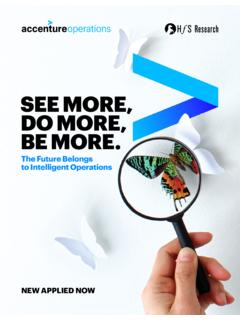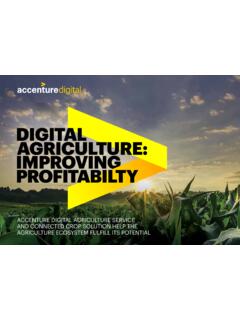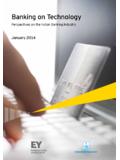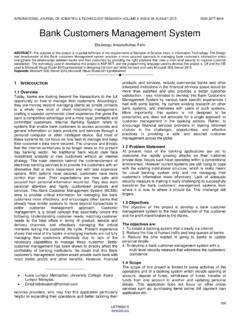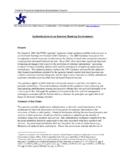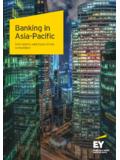Transcription of BUILDING THE FUTURE- READY BANK - …
1 BUILDING . THE FUTURE- READY BANK. banking Technology Vision 2018. Contents Introduction 3. Trend 1. CITIZEN AI 5. The Newest Member of the Bank Workforce Trend 2. EXTENDED REALITY 9. The End of Distance Trend 3. DATA VERACITY 15. Build the Future on Truth Trend 4. FRICTIONLESS BUSINESS 19. Built to Partner at Scale Trend 5. INTERNET OF THINKING 24. Put Smart banking on the Edge of Consumer Interactions References 29. Survey Population and Methodology 30. 2 banking Technology Vision 2018 BUILDING the FUTURE- READY Bank Next chapter in the FUTURE- READY Bank Series Introduction REVOLUTIONS. MAKE FOR. GOOD COPY. The journalists standing at the Berlin Wall when it came down witnessed a sudden and truly disruptive change that reset the geopolitical landscape of Europe for a generation.
2 In business, the rapid reversal of fortunes of Blockbuster, BlackBerry , Myspace and Kodak will live on for generations as business school case studies that demonstrate how market leaders can be overthrown by innovative insurgents. In retail banking , we're witnessing one of those revolutionary moments in China. With over billion active users,1 Alipay and WeChat are reshaping the payments landscape with a deluge of innovations that are making both cash and traditional card payments anachronistic in some cities. While mobile payments languish in the low single digit percentage in the US, more than half of WeChat's users scan a quick response, or QR, code regularly to pay at a retail location,2 and Alipay's pay with a smile is using facial recognition to let consumers buy fast With Ant Financial (Alipay's parent) having the most blockchain patents and live blockchain production systems of any financial institution in the world4 (and they are also BUILDING a payments system that can handle 100 billion transactions a day), the accelerating pace of change in China shows no sign of abating and we are truly witnessing a great leap forward.
3 India may also be in the early days of this type of payments revolution, with mobile payment volumes up 22 times in a 12-month period5 and with the combination of demonetization and standardized mobile payments infrastructure driving rapid adoption. 3 banking Technology Vision 2018 BUILDING the FUTURE- READY Bank Next chapter in the FUTURE- READY Bank Series Introduction In contrast, the pace of change in more SME credit and mortgages are bastions for developed retail and commercial banking incumbent banks in mature markets like markets appears to be more evolutionary Canada. than revolutionary. The would-be rebels see the EU's second Payment Services Directive The speed at which a specific retail and (PSD2), the UK's Open banking initiative, and commercial banking market changes mandated data sharing in Australia as game is clearly not just about the speed of changers and pre-cursors to radical change; technological change, but also the complex and over time, they may well be.
4 Yet, current interplay of many other factors including the evidence suggests that, in most of these regulatory environment, industry economics, markets, incumbent banks have managed level of customer satisfaction with existing to avoid the waves of digital disruption that providers, and the structure of competition have washed over other industry sectors. In in the sector. That being said, technology Europe, there is no shortage of new entrants, is a critical driver of change in the banking with 20 percent of the players in the retail industry and a key factor that all players (new and commercial banking space being and old) need to understand if they are going created since 2005,6 and they are playing in to successfully navigate the choppy waters of every space from payments, to consumer either revolutionary or evolutionary change.
5 And SME lending, to robo-advice. However, In this paper, we place a banking lens over to this point, they have only captured about the five emerging tech trends highlighted percent of the industry revenue and an in the cross-industry Accenture Technology even smaller portion of the profit Vision 2018. Each of these IT trends could In the US, for all the fintech innovation we potentially generate the next wave of industry have seen, the story since the financial disruption that banks can ill afford to ignore, crisis in consumer deposits has been even in markets that currently look stable further consolidation rather than increased and profitable. Only by understanding these competition. In 2007, the top three banks trends can banks ensure that they are truly in the US held 20 percent of deposits while future READY .
6 In 2017 that number rose to 32 Of the nearly 800 bank business and As digital account openings become more IT executives from across 25 countries common, market share has moved not to interviewed in the global Accenture new entrants, but instead to incumbents Technology Vision 2018 survey, 86 percent who can afford to invest billions of dollars agree that technology is increasing the in a great digital customer experience. In level of integration between financial 2017, new checking account openings in services and the rest of their customers'. the US were dominated by the established lives. To prevent being marginalized and players, with 45 percent being opened at pushed to the ends of the value chain, the three national Those who are banks are going to need to go beyond losing share are the smaller institutions who current products and services and create have been reliant on their branches as the compelling living services that are highly fly paper for deposits.
7 In US credit, there has personalized and relevant. Whether that been more change. Over one-third of small change is coming fast as it is in some of and medium-sized enterprises (SMEs) that the emerging markets or somewhat slower borrow now use non-traditional lenders10. in the more developed economies, there is and mortgage originations are dominated by no disguising the fact that technological specialists not banks. Again, the profile of change is going to rewrite the rules of the change is very market specific; for example, banking industry over the next decade. 4 banking Technology Vision 2018 BUILDING the FUTURE- READY Bank Next chapter in the FUTURE- READY Bank Series Trend 1. CITIZEN AI. The Newest Member of the Bank Workforce 5 banking Technology Vision 2018 BUILDING the FUTURE- READY Bank Next chapter in the FUTURE- READY Bank Series Trend 1 Citizen AI.
8 AI may be the next big thing for many industry sectors, but banks are veteran users of this technology. The first neural networks for automated As AI becomes a more visible co-worker that credit decisioning were built over 20 years can make autonomous decisions, legitimate ago, and banks already make extensive use concerns are being raised about the of AI to automate repetitive, rule-based processes through which an AI makes those manual tasks, such as AML transaction decisions and whether those decisions are monitoring and credit card fraud detection. being made within the right regulatory and Yet today, AI is evolving to offer a far more ethical context. For example, Capital One . comprehensive set of cognitive capabilities is researching ways to use AI for a variety that can sense, comprehend, act, and of functions, including deciding who is learn.
9 These capabilities allow AI-powered granted a credit card, while maintaining a machines to interact far more naturally with high bar of Bank of America both customers and other employees in ways and its Chief Operations and Technology that not only easily pass a Turing test,11 but Officer, Cathy Bessant, are helping lead the also display humor, emotional sensitivity, and way to responsible automated intelligence, . other very human traits. According to our as she calls it, focusing on ensuring that survey, 79 percent of bankers believe that algorithmic or automated models are also within the next two years, AI will work next to Ultimately as banks maximize humans in their organizations as a co-worker, the power of AI, banking regulations, such collaborator, and trusted advisor.
10 They also as the European Union's soon-to-take- expect that the majority of bank-customer effect General Data Protection Regulation interactions will be conducted via AI in the (GDPR), will raise the accountability bar next few years, making machines the face on consumer data handling whether of the organization. conducted by humans, machines or both. One of the more visible signs of this trend As AI develops decision making capabilities, is the emergence of collaborative robots, it can't be a black box. Instead, it needs or cobots, that work alongside humans to to be subject to the same constraints and help them do their jobs better and give transparency rules as any other employee. customers a better banking experience. Bankers overwhelmingly recognize the In 2016, Bank of America debuted Erica, importance of this transparency.


